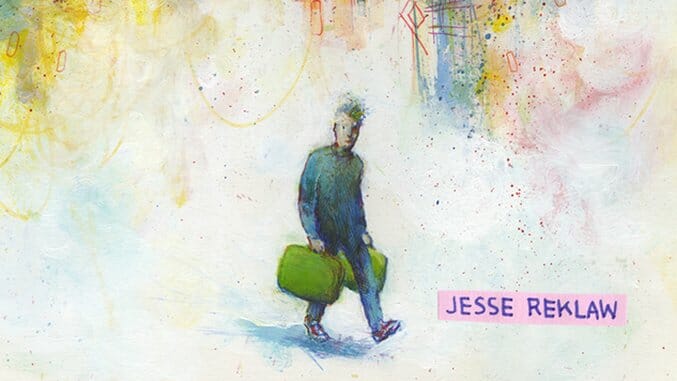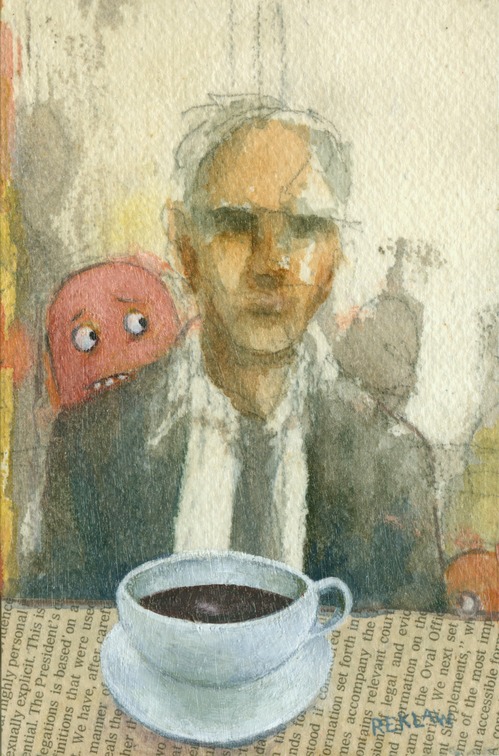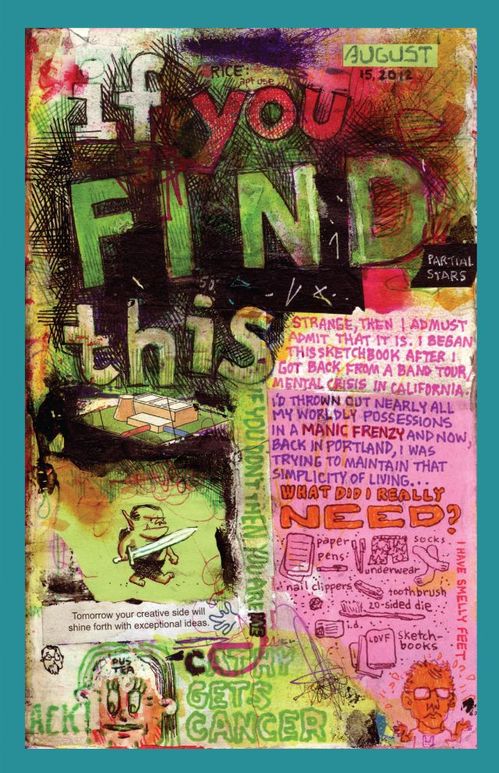“Change seems to happen me…no matter how hard I try to be stable”: Jesse Reklaw on his Manic Cross-Country Trek in Lovf
Cover Art by Jesse Reklaw Comics Features
Jesse Reklaw’s Lovf is a tough read. Its subtitle is An Illustrated Vision Quest of a Man Losing His Mind, but even that doesn’t prepare you for the autobiographical tale between its covers. The graphic novel unspools Reklaw’s experience during a months-long manic phase, during which he wandered from one side of the country to the other. Homeless, with almost nothing to his name but the sketchbook he later transformed into this comic, he goes from bad to worse. That said, there are elements of the book that are simply exhilarating. Reklaw overlays a narrative on top of already crowded pages, alive with color and collage, conveying the joy of the highs that come with bipolar disorder without minimizing its downside.
The cartoonist was nice enough to put up with our prying into his private life in a series of emails, during which he explained how he’s evolved as an artist over the course of his career.![]()
Paste: I read an interview with you from April in which you said you were both excited and terrified to go out and promote this new book. How’s that going? More exciting or more terrifying so far?
Jesse Reklaw: It’s been surprisingly kind of easy and low-key. I find that at each event someone comes up and tells me about a mental illness issue they have. Or, I don’t know if “mental illness” is the right word, but you know. I guess it’s been real human to relate to people about that kind of stuff.
Paste: Lovf is drawn (painted? scribber-scrabbered?) in the same style as some of the stories from the end of Couch Tag. How’d you come to that style, especially when it’s about 180 degrees away from your more controlled, traditional comics-style line drawing?
Reklaw: I have been working with collage and mixed media for a long time, but it’s taken until now for me to find the confidence and facility to use it in comics. (I’ve attached a couple jpegs of some mixed media paintings I did around 2004 that were part of this stylistic development.) I am also quite inspired by Lynda Barry’s latest work (and all of her work—but especially the mixed media stuff she’s done, like in What It Is).

Mixed Media Paintings by Jesse Reklaw
Paste: Do you think the more collagey style helps you tell certain types of stories better?
Reklaw: I think the style was more an effect of my mental state at the time. After I had a nervous breakdown/manic phase and was put on mood stabilizers and anti-psychotics, I found it difficult to draw the way I used to (among other things). In particular, it was difficult to make choices about lines and compositions. I found it easier to build up an image from scribbles and patches of color, instead of deliberately constructing things in the traditional comics process of: thumbnails, pencils, inks.
Paste: It certainly seems to promote collaboration, or maybe that’s just a function of this book evolving from a notebook.
Reklaw: I have always enjoyed collaborating with other cartoonists and artist friends. I learn a lot that way, and I think it’s a fun meta-narrative about who I was with during the process of making the book.
Paste: I have to say it kind of stresses me out, that style. Is that the intent? Or is that my problem (entirely possible; I think I’m a fairly tightly controlled person)?
Reklaw: Oh no! I don’t want to stress anyone out…! I guess I found making the book stressful at times, but ultimately very freeing.

Mixed Media Paintings by Jesse Reklaw
Paste: Can you talk a little bit about the whole process of the book’s evolution from sketchbook to finished product (i.e., making it read more like a story and less like stream-of-consciousness)? Was it difficult to wrestle it into a more linear form?
Reklaw: I forget exactly how it happened, but at some point I wrote stories on scraps of paper and pasted them over some pages. Months later, when I’d stabilized on my meds and wasn’t sleeping 12-15 hours a day, I took a look at the book again and thought it kind of worked in a comics-y way, marrying the manic marker drawings with torn paper narrative. I posted pages on Facebook as I finished them, and a friend who runs a small press (Robyn Chapman at Paper Rocket) offered to publish it in some form. I managed to flesh out a 28-page excerpt of my New York crisis parade, which she published as a one-shot. That got enough positive reception that I thought it would be worth Kickstarting it. Sorry to drag this out, but the crux of it is, when I got the funding and a publisher for the book, the heat was on.
Then it wasn’t breezy or magic putting the book together. It was a three-year emotional hemorrhaging to revisit everything. Plus it was a lot of work to simulate that crazy, layered style, and to shape a mess of pages into a “graphic novel.” I’m sure I wouldn’t have finished that book if I hadn’t felt beholden to people. I drew half of that sketchbook in three months, and it took me three years to finish the other half!
Paste: When you sketchbook, do you go in order from the first page to the last or do you skip around?
Reklaw: It starts linear, but I go back and work on things.
Paste: Why the rainbow edges on the book? Just to tie it together? I assume those were not in the original sketchbook.
Reklaw: The drawings in the sketchbook cover the pages, with lettering up to the borders. So the whole thing had to have a margin, in order not to lose crucial imagery and words when it was trimmed. I guess the margin could have been white (or black), but I had been inspired by Lynda Barry’s books that have pastel margins. Using different colors allowed me to indicate chapter changes… as well as amplify the rainbow imagery in the book as well as the themes about publishing and authenticity.

Lovf Interior Art by Jesse Reklaw
Paste: Favorite pens/art materials to work with?
Reklaw: I really got into markers with this book… the Uni-ball Signo white pen is the best ever! Letraset Promarkers are affordable and juicy, and Zig Millenniums hold a fine tip, compared to Microns which really seem to have lost quality over the years. I also like to use watercolor and acrylic paints.
Paste: So tell me about how you came to comics (and art in general) from computer science? That’s obviously not the most common route to take.
Reklaw: It’s a little more twisted: I was a math-science nerd in high school, but then had a big manic phase around age 18. I dropped out of college, put up some arts shows, and was in a few rock ’n’ roll bands; meanwhile I made my first minicomics and submissions to comic book publishers. When I went back to college three years later, I fully wanted to be an artist, but doubted the economic viability of that career, so I double-majored in computer science as well.
Paste: Do you think any of your computer science training affects how you make comics? Or are they totally separate?
Reklaw: Absolutely. I studied computer vision for a while, and how to make sense of visual information on a scientific level. That gave me a solid framework for manipulating images and working with the cognitive effects of different styles and media.
Paste: Is it easier to create when you’re in a manic state?
Reklaw: It’s very easy to start projects, and to visualize big schemes. But not all of the work is useful later.

Lovf Interior Art by Jesse Reklaw
Paste: Consider this a totally insensitive question and you don’t have to answer it if you don’t want to: do you feel like you came to comics and art-making late in life? You were born in 1971, but you still seem to live a somewhat bohemian life. How does that affect the art you make?
Reklaw: Comics are so hard to make! There’s all these different disciplines to study: writing, drawing, design, lettering, coloring, etc. Also, being involved with the DIY/self-publishing community, I devoted myself to learning about publishing, distribution, printing and other areas on the business side of the medium. Meanwhile I guess I still pursued computer science (and rock ’n’ roll), so that’s how I explain to myself where I’m at now. I did self-syndicate my first comic strip nationally in 1995, but it’s taken me a while to feel confident writing long-form fictional comics. I’m probably not answering your question, sorry.

Lovf Interior Art by Jesse Reklaw
Paste: You’re definitely answering my question to some extent. And some of my perspective is informed by my squareness. Are you okay with instability as a way of life? I tend to crave a lack of change, but some people (maybe you?) are more restless. I can draw both comparisons and distinctions between Lovf and Ellen Forney’s Marbles, which covers some similar territory. Forney seems to look back on her highs and lows/mania and depression as more of a negative thing, whereas you seem to take that aspect of yourself more in stride, as just one component of who you are. Is that a fair characterization? And, if yes, why do you think you present yourself more just as a person and less as a “survivor”?
Reklaw: There were times in my life when I settled down early (my first serious relationship was from ages 19-30), and when I thought touring and performing with a band was impossible. I don’t know if I crave change, or it’s more the tail wagging the dog: change seems to happen me, drastic and irreparable change, no matter how hard I try to be stable, or how much I want to return to the desires and identities I used to feel comfortable with. It was certainly confusing for me at 18, when I had been high school valedictorian and courted by Harvard, to instead drop out of school, work at a cafe, and pick up a guitar for the first time in my life.
When I talk to other people about their life changes and milestones, it seems to me that mine are always more extreme. The 28-year-old me was totally different than the 27-year-old me. So perhaps it’s my response to those powerful internal forces that makes me seem restless and unstable. On a small scale, I’ve learned to normalize some of my scary behaviors. But for the big stuff, I just don’t have any way of addressing that. If five years ago I wanted to be a dad with a day job, and today I want to be a drummer on tour… I have to accept those new desires and goals. It would be totally irrational to let 5-years-ago me direct this life now.
I liked Ellen’s book. She did celebrate some aspects of neurodiversity, as well as owning some bad behavior. I don’t know her that well, but I would not be surprised if she started a band or joined the circus tomorrow.
As for being a survivor, I’ll use that language when I’m trying to repeat the things I’ve been told about how childhood trauma can lead to adult anxiety, which in turn can explode into a variety of symptoms, both mental and physical. But it’s not a label or an identity that I carry around with me.
